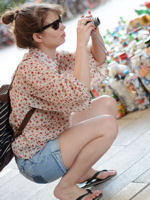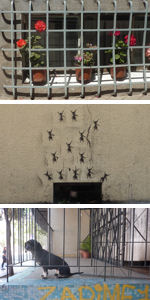Review: Photography tour, Santiago
Budding snapper, Cherry Casey, gets a new perspective on Santiago during a photography tour of the Chilean capital.
Liber Bernardo O’Higgins, the main road running through downtow Santiago, is surprisingly empty this morning; the crowds, and the 35°C heat, have yet to arrive. But quiet it is not. On one side of the road, a military memorial service is taking place - a reminder of the prominent role that the army still has in Chilean society - and on the other, as if to lighten the mood, two musicians blast away on a clarinet and accordion. They play to everyone and no-one in particular.
I continue walking down the street and within a few minutes, I’m at a large square building that looks as though it's made from rusty metal. This is the Centro Cultural Gabriela Mistral, or the GAM, and is the meeting point for Foto Ruta's photography tour.
‘I suggest starting off here because it’s such an interesting space; it’s ideal for experimenting with your camera,’ explains Cat Allen, the British expat and professional photographer that’s leading our morning of ‘creative seeing’.
There are just two of us in the group but I’m humbled by the sophisticated cameras on display as I present my compact Lumix. But Cat assures me that the tour is for all ages and levels (she even offers one for smartphone users), and gives me a quick rundown of my camera’s features that I didn’t know existed (macro settings anyone?).
 Cherry in action
Cherry in actionThis is perhaps one of central Santiago’s trendiest areas. It's also one of the prettiest, with its 19th century buildings, vibrant bars, restaurants, art galleries and boutiques. We amble along at a relaxed pace, encouraged by Cat to explore the area as we want. In my hunt for photo opportunities, I find myself focusing on the more unusual details around me; bright potted plants imprisoned behind grey window bars, a tiny dog sitting on what looks like his own personalised balcony and giant ants crawling up a wall (which is actually just well-placed graffiti).
A different perspective
As we leave Lastarria, the streets become less colourful and well-kept, but are by no means ugly. In fact, it feels more like the authentic Santiago. We wander through residential blocks, again stopping to everyday life in the Chilean capital. A man selling flowers from a booth on the roadside agrees to be our model, while a deserted, beaten up taxi has no say in the matter.
Having lived in Santiago just under two years, Cat is no expert on the history of the city and the buildings we pass. Nonetheless, she reveals small insights into the Chilean way of life as we wander the streets, ranging from the widespread kindness bestowed on stray dogs to the unfortunate ‘it’s who you know’ culture that governs many aspects of society.
We pass the leafy Parque de Forestal, the central park that houses the Museo de Bella Artes, but rather than veer towards this stately building, we turn down onto Esmerelda. A slightly more rundown area of town, Esmerelda still exudes a certain charm and again, I look at details more closely than I would have normally; the contrast of neon-coloured convenience shops sitting underneath crumbling grey balconies for instance, and the Swiss chalet-like buildings that seem incongruous against their Latin American neighbours.
 The city's bustling Mercado Central
The city's bustling Mercado CentralCat Allen
From here, we head to our final destination, Mercado Central, a busy fish market where you weave between tightly packed stalls, swathes of fishmongers and all manner of seafood piled high. Still too shy to take photos of strangers, I just wander around soaking up the atmosphere (while worrying about what my increasingly wet, flip-flopped feet are also soaking up).
The pièce de résistance of the Mercado Central however is at its centre. Here, a towering, ornately designed cast iron roof (actually made in Glasgow in the 19th century), gives the feeling of a grand train station, packed full with restaurants and waiters vying for our attention. Cat makes a beeline for one in particular and, after an enthusiastic exchange with the proprietor, we are ushered to the first floor restaurant, where we’re afforded an exclusive view of the scene below.
After a few final shots we take a table downstairs, admire our morning’s handiwork and tuck into a bottle of cold white wine with bread and pebre (a Chilean salsa that’s found on every restaurant table).
Our four hour tour has raced by. I leave the market feeling invigorated – Santiago isn’t especially easy to appreciate by aimlessly wandering, so a gentle steer in the right direction has been ideal. While I was unsure of how much I’d take away from the experience, other than some useful photography tips, I do actually feel that I’ve seen Santiago more authentically and creatively than as a regular tourist.
 Cherry's street scenes
Cherry's street scenesIDEAL FOR…
The tour has slightly more emphasis on photography than on Santiago, so if you’re an amateur who’s upgraded to a professional camera and want to put more thought into your photography, then it may be ideal for you.
WORTH THE PRICE?
My StreetScape tour is pricey, considering we are using our own equipment, but the small group sizes means that the route can be tailored to suit particular interests, which is a bonus.
ROOM FOR IMPROVEMENT
More information on the history of the buildings and areas we’re exploring would have enhanced the experience.
TIPS
The tour starts at 930am and finishes at 230pm so the heat will crank up. Be prepared by taking sun cream and sensible shoes are a must.
When it comes to your individual camera, it would be a good idea to familiarize yourself with your camera’s features before you start the tour. And whatever you do, have a fully charged battery and carry a spare.
RATING:
4/5
DETAILS:
Foto Ruta (tel: (02) 569876 66844; http://foto-ruta.com) runs different tours almost every day of the week, in addition to private and bespoke tours. There is also a branch in Buenos Aires.
Price: US$32-$95.
Do you have any Feedback about this page?
© 2025 Columbus Travel Media Ltd. All rights reserved. No part of this site may be reproduced without our written permission, click here for information on Columbus Content Solutions.









 You know where
You know where